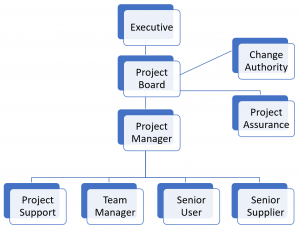
PRINCE2 is one of the main project management methodologies in use in the world today. PRINCE2 is built on the foundation of project roles. There are 9 roles outlined in the method, which all must be filled even if the same person fills multiple roles. These roles are:
- Executive
- Project Board
- Senior User
- Senior Supplier
- Project Assurance
- Change Authority
- Project manager
- Team manager
- Project Support
Executive
The executive secures funding for the project and maintains the business case and justification for the project. Similar to a “project sponsor” in other methodologies, they accept the project’s deliverables and focus on the benefits that the project provides to the organization, or to the program or portfolio that the project is a part of.
The executive appoints the project board and the project management team.
Project Board
 All PRINCE2 projects must have a project board. The board, like a corporate board, is accountable to the customer or client for the success of the project. It provides direction and advice to the project.
All PRINCE2 projects must have a project board. The board, like a corporate board, is accountable to the customer or client for the success of the project. It provides direction and advice to the project.
The project board sets the tolerances of each stage, and when the project deviates outside those tolerances, it has lost the confidence of the board and an exception plan must be approved. This plan replaces the stage plan for the rest of that stage.
For example, if the budget for a stage is $10,000, with a tolerance of 20%, the project board must approve an exception plan for any budget variances over 20%.
Senior User
 Projects produce a unique product or service, which usually results in some form of change to the parent organization. Hence the recipient of those products or services need to be involved during the project.
Projects produce a unique product or service, which usually results in some form of change to the parent organization. Hence the recipient of those products or services need to be involved during the project.
The senior user represents those for whom the project will achieve an objective, or those who will use the product to deliver benefits. They test the product to ensure that the benefits will be realized.
They specify the needs of the end users and liaison with the project management team to ensure the quality and functionality of the end product will satisfy the project’s business case.
Senior Supplier
 The suppliers are all the people and/or organizations that carry out the project work, that is, they produce the project’s deliverables. It includes the internal (the project team) and external suppliers. It can also include those who will support and maintain the products once the project is done.
The suppliers are all the people and/or organizations that carry out the project work, that is, they produce the project’s deliverables. It includes the internal (the project team) and external suppliers. It can also include those who will support and maintain the products once the project is done.
The senior supplier represents the interests of the suppliers. Usually, suppliers wish to be fairly compensated for their work and receive a positive reference for future work. Work satisfaction is also high on the list.
Project Assurance
Project assurance is the role of measuring the status of the project and reporting it to the project board. It can include any area – Budget, schedule, and quality are usually near the top of the list.
The project assurance role reports to the project board. They are intentionally independent of the project manager.
Change Authority
Although the project board is responsible for approving changes to the project plan – scope, budget, timelines, etc. – there are many projects where changes require a greater level of scrutiny, or technical knowledge. Also, the anticipated volume of changes sometimes requires a separate Change Authority.
This Change Authority reports to the project board. It analyzes potential project changes and recommends a course of action. The authority level must be specified during the Initiating a Project process, to ensure that decision making authority is clear prior to project execution.
Project Manager
 The project manager manages the day to day activities of the project. They are delegated the authority by the project board to make decisions which affect the outcome of the project. The project board approves the project plan which specifies the tolerances under which the project manager’s authority is defined. Once the project deviates outside of those tolerances, the project manager must produce an Exception Plan which replaces the Stage Plan for that stage, and this must be approved by the board.
The project manager manages the day to day activities of the project. They are delegated the authority by the project board to make decisions which affect the outcome of the project. The project board approves the project plan which specifies the tolerances under which the project manager’s authority is defined. Once the project deviates outside of those tolerances, the project manager must produce an Exception Plan which replaces the Stage Plan for that stage, and this must be approved by the board.
The project manager liaises with the project board and project assurance on an ad hoc basis, to receive advice and direction on how to proceed.
They manage the team managers as well as project support. For small projects these roles can be fulfilled by the same person.
Team Manager
 The Team Manager is a lower level manager who is responsible for the day to day production of the project’s deliverables. They report to the project manager. They might have many project team members underneath them or they might be doing all the work themselves, but they are the technical expertise.
The Team Manager is a lower level manager who is responsible for the day to day production of the project’s deliverables. They report to the project manager. They might have many project team members underneath them or they might be doing all the work themselves, but they are the technical expertise.
The team manager generates work packages which are allocated to project team members for production. A series of work packages becomes a management stage.
As a minimum, one person could carry out the project manager, team manager, and project team roles (if they were the only person carrying out the project work). But this does not negate any of the project roles – Each of these roles are still present and must be performed.
Project Support
 Reporting to the project manager, project support provides administration, advice and guidance to the project manager. Many organizations have a project management office (PMO) which provides this support role to the project manager. Although the roles and responsibilities of PMO’s vary greatly from organization to organization, the project support role in PRINCE2 is one of supporting the project manager in project management functions, like project scheduling, control, or risk management.
Reporting to the project manager, project support provides administration, advice and guidance to the project manager. Many organizations have a project management office (PMO) which provides this support role to the project manager. Although the roles and responsibilities of PMO’s vary greatly from organization to organization, the project support role in PRINCE2 is one of supporting the project manager in project management functions, like project scheduling, control, or risk management.
Although it may seem in some cases unnecessary, the project support role is not optional. Like other roles, the same person can play multiple roles but this does not negate the existence of the role. In this case, the project manager or team leader are the only people who can play this role.
Project support should not be confused with project assurance. Although the roles are similar, project assurance reports to the project board, and thus provides independent advice to the project board, whereas project support reports to the project manager.






